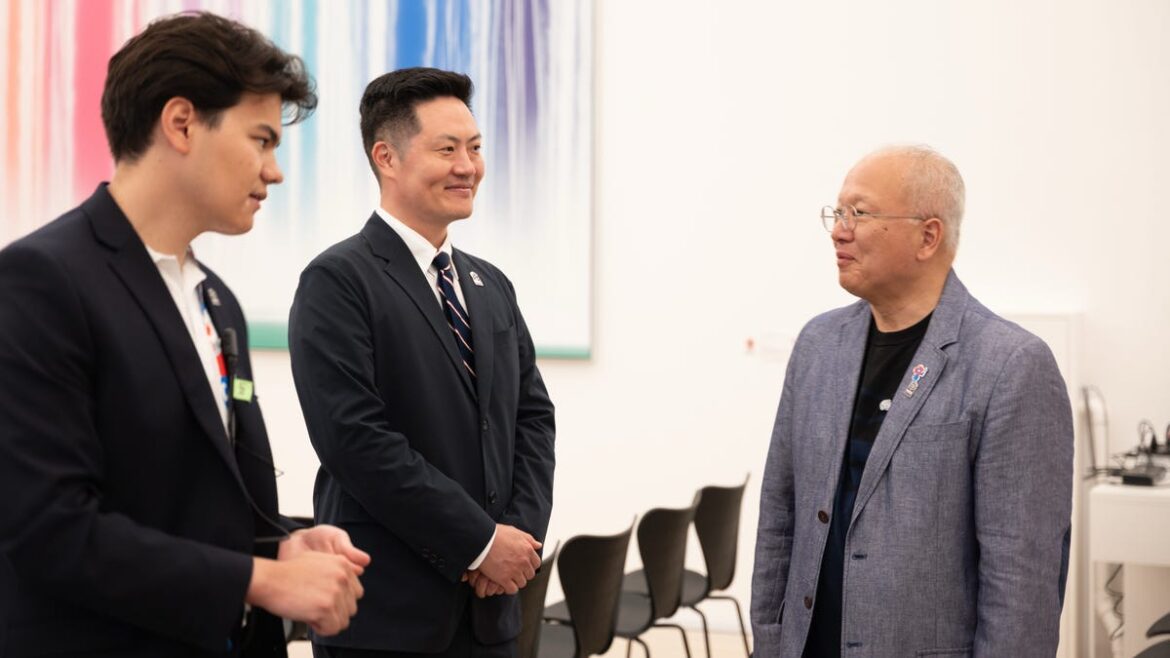Just off of Osaka, Japan, is a man-made island where for the next six months, more than 150 countries will be housed. These countries will welcome tourists and world dignitaries, showcasing the best of what they have to offer. The 2025 World Expo, which used to be called the World Fair, is hosted this year from April to October in Osaka.
A bit of Cape Cod is there.
“The expo this year kind of feels like a theme park, like Disney World. It feels like every ride is a different country,” said Lee McGuire.
McGuire, and his brother Kai, have spent most of their summers at their grandparent’s house in Dennis. McGuire is a youth ambassador as the USA Pavilion while his brother was appointed by the State Department as the Director of Protocol and responsible for hosting dignitaries and VIPs, according to their father, Matthew McGuire.
The major World Expos happen every five years at a different location and each country will build their own pavilion. McGuire called it the “Olympics, but for culture.” The theme for this year’s expo is: Designing Future Society For Our Lives.
“The mission at hand is not just some company and their profits, it’s a real world connection that I feel a very personal attachment to,” said McGuire. He is Japanese on his mother’s side and American on his father’s side. Growing up, he and his brother studied in Japan, at an American school, and spend their summers in Dennis.
“It’s like a second home to me.” He recalls playing basketball at the Mid-Cape Hoop School.
What is a youth ambassador at the 2025 World Expo?
As a youth Ambassador, Lee McGuire spends each work day arriving at the USA Pavilion, checking the jobs posted on the white board, and deciding what he will be doing for the day.
“I typically like to do tour guiding, because I like interacting with the guests,” he said. He’ll usually do four or five tours that last about 30 minutes, each group being around 120 people.
McGuire applied for the position through Sister Cities International, after seeing an advertisement online. For him, though, it’s more than just a nice addition to his portfolio.
“Anything to do with U.S. Japan things, it’s kind of my passion, I really love getting involved,” he said, “I think being able to show my people, how great my people are, show Japanese people how great American people are, makes me really happy to go to work everyday.”
More than 1,500 applicants applied to be a youth ambassador, but only about 88 were selected. Some will stay for the full six months, April to October. Others like McGuire, will return to the U.S. in July, when another cohort will begin their ambassadorship. A rising senior at The George Washington University in Washington where he studies international affairs, McGuire took a gap year for this opportunity.
The USA Pavilion at the World Expo
The goal of the World Expo is to bring countries and people together to share cultures and innovations, according to McGuire. Some countries might use their pavilion to promote tourism or increasing trade. The cost of a one-day ticket to the expo is 7,500 yen, or about $52.
“The USA — along with a lot of other countries — but the USA specifically, really wanted to have a big holistic approach to the expo,” McGuire said. “Our catchphrase is, ‘Imagine what we can create together.'”
Showcasing American excellence is the overarching theme of the USA Pavilion exhibit. Other themes in the exhibit are meant to show and encourage strong ties between the U.S. and Japan, according to McGuire. There are four themes that make up the exhibit at the U.S. Pavilion: Connecting, Innovation, Travel, Space.
Upon entering, visitors learn about opportunities for work or study in U.S. as they walk through the main hallway. The first exhibit is focused on scientific innovations and new technologies being made in the U.S. Next visitors will enter ‘Travel,’ which showcases the diversity in the U.S. as a place to visit. Destinations shown in a video include Massachusetts cities. “Boston and Cambridge, no Cape unfortunately, but that’s okay,” said McGuire.
The fourth room, ‘Space,’ is NASA themed, which shows the history of space travel and aerospace technology in the U.S. Visitors will also learn about the ways NASA and Japan’s Aerospace Exploration Agency (JAXA) have worked together.
“That room ends with a preview into what’s called the Artemis Missions. The U.S. is, in the next couple years, going to go back to the moon for the first time in decades,” said McGuire. The first of four Artemis Missions took place in November 2022, and the next few trips to the moon will take place in 2026 and 2027.
The final part of the exhibit is the Cube, a space launch simulation. “You are basically taken through space. There are smoke effects and rumbling. It looks very cools, it’s very convincing,” said McGuire. Another fun artifact tourists will see is a moon rock that was brought back from the Apollo 17 mission in 1972.
“That’s actually really special specifically for Japan because Osaka, the city that’s hosting the expo this year, hosted the expo in 1970. The U.S. Pavilion in 1970, their crown jewel, was a moon rock. So, we’re paying homage to that 50 years later,” said McGuire.
Desiree Nikfardjam is a reporter covering breaking and trending news. She graduated from Columbia University’s Graduate School of Journalism. You can reach her at DNikfardjam@gannett.com.
Thanks to our subscribers, who help make this coverage possible. If you are not a subscriber, please consider supporting quality local journalism with a Cape Cod Times subscription. Here are our subscription plans.


AloJapan.com